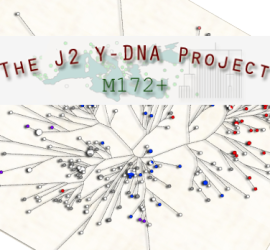Dear visitor: J2-M172 Haplogroup Research is done by volunteer citizen scientists and admins.
Please be patient when you encounter unfinished and outdated areas.
Yearly Archives: 2013
Basic skeleton and team is ready
Since September 2013 the new J2-M172 Research Team has developed several basics to achieve the best possible setup: Team speciality areas; New logo (see design steps); Publication of J2a-M410 phylogeny research (all clades); Publication of simple SNP tree; New J2-M172 Haplogroup Research page – this one here 😉 Screen Design for FTDNA homepage; To Do: Kit Grouping/Clustering FTDNA homepage Haplogroup […]
Minimal reference J2 phylogeny
The makers of the mtDNA reference phylogeny (Mannis van Oven, et al.) did setup a “minimal reference” for the Y-DNA haplogroups. Team members are in contact with Mannis to achieve an updated and optimized J2-M172 minimal reference: . Primary goals of www.phylotree.org/Y/: […] optimal global discrimination capacity based on a strongly reduced set that includes only the most resolving Y-SNPs. […]
J2 phylogeny in 1000 Genomes Project
Under the lead of Greg Magoon a group of citizen scientists (including J2-M172 team members Bonnie Schrack and Chris Rottensteiner) were involved in the analysis of a high-resolution a priori maximum parsimony Y-chromosome (“chrY”) phylogeny created from data of 1292 male samples in the 1000 Genomes Project. 63 of those samples are in haplogroup J2-M172 (42 in J2a and 21 […]
J/J2 fusion under way @ FTDNA 1
J2-Project admin Angela Cone who has blogged in Nov. 2012 about the reasons of low activity since 2008: “Sir Nico, Earthquakes, and Hypodopaminergia” and already announced her wish to have of team of co-admins, everyone dedicated to a speciality area. “Before this new J2 project incarnation can fully emerge, there will be a period of metamorphosis over the next few months. Behind […]
Y-DNA J-Project @FTDNA History 2006-2013
The “J-Project” was founded by Bonnie Schrack in 2006 and until 2013 has done considerable research in the J2 area, mainly SNP research (Z385-Z639, Z2220-Z2397) from public Y-Sequences to improve the Haplogroup-Phylogeny and provide updates to the ISOGG tree (accepted also by scientists). To backup important news from this time period and make them available for search here, a copy […]
J2 Y-DNA Project @FTDNA History 2007-2013
The “J2 Y-DNA Project ” was founded by Costa Tsirigakis and Angela Cone in 2006 and until 2013 has done considerable research in the J2 area, mainly STR-Cluster research to provide an answer to the question if sub-clades can be reliably predicted from extended haplotypes. See Site Map for full content of the original pages (Scientific process, Third phase results, […]






